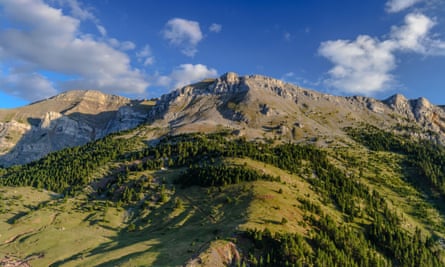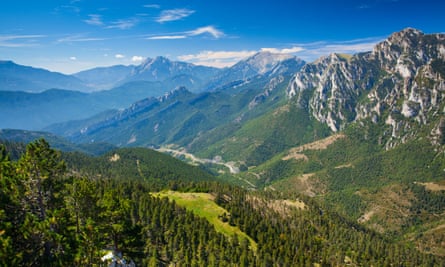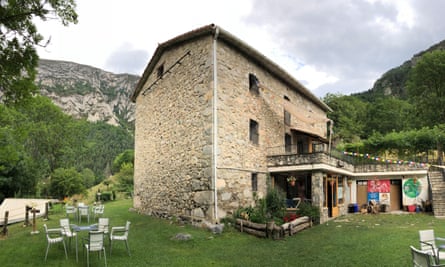“You’ve brought the rain with you! Thank you! It hasn’t rained here for two months!” Jordi, piebald-bearded guardian of the isolated Prat d’Aguiló refuge, greeted my companion and me with such effusive smiles and enthusiastic handshakes we almost wondered if he held us personally responsible for ending his local drought.
We had long wanted to go hiking in the Pyrenees and, at just 52 miles, the Cavalls del Vent trail seemed an ideal way to cut our teeth. The circular path winds around Catalonia’s Cadí-Moixeró natural park, uniting eight mountain refuges that open for walkers during the summer (from 12 May to 14 October in 2023) when the snow has gone.
Our first view of the sunlit mountains, seen from the train, had certainly whetted our appetites – sheer cliffs high above us resembling a ragged row of sugar-white teeth. And though it was a sultry 30C when we rolled into Barcelona, our bus the next morning took us swiftly up into the cooler air of Bagà, the nearest town to the Cavalls del Vent circuit and the spot from which most walkers start. The sound of thunder rolling around the peaks above us as we took the first steps of our hike added a pleasingly dramatic touch (especially since I had omitted to bring anything waterproof – for me or my rucksack).

Jordi told us how Cavalls del Vent had been created. “Some of us refuge wardens explored the old paths through the mountains. Many of them had been abandoned so we had to work to reopen them – in all it took us about a year.” He explained that July and August were the most popular months for hiking the route but his favourite month was September “because you can enjoy all the changing colours of the forests”.
Most hikers take five or six days to complete the round. Not wanting to rush, we opted for six days, booking five roughly equally distanced refuges, with dinner and breakfast included. There are no shops en route, so we also ordered packed lunches from the refuges and a “welcome pack” that contained goodies such as a Cavalls-branded walking shirt and buff, various victuals, an excellent map and the number for a 24-hour support phone line (thankfully we never had to test the efficacy of this).
And so we set off, following orange blobs painted on to rocks and trees along the way, interspersed with occasional informative fingerposts. We strode steeply uphill towards our first port of call, Refugi Niu de l’Àliga – the sole ski station refuge on the circuit and, at just over 2,500 metres, the walk’s highest point – and in no time the mountains had swallowed us up. It felt as if we had this corner of the Pyrenees and its rumbling skies all to ourselves.
Such was our joy in this seclusion that each day we amused ourselves by keeping a tally of the number of people we saw as we walked; the highest for a single day was 21. When we reached Niu de l’Àliga we found we were in fact their only guests that night. By then we’d already had our first of many encounters with the local isards, the small chamois that roam the Pyrenees in shy little herds.

Cavalls del Vent means “horses of the wind”, a name inspired by the Buddhist prayer flags that flutter about in the breezes of the Himalayas. True to that ideal, the trail stays high its whole length: even its lowest point is a respectable 840 metres. This had two effects we noticed almost immediately. First, the air was a joy to breathe – like sipping Château de Chasselas after years of house white. More prosaically, the altitude made all the crisp packets behind the bar at Niu de l’Àliga balloon like puffer fish – a sight that would doubtless have entertained Picasso, whose 10 weeks in nearby Gósol refreshed him and revolutionised his art.
after newsletter promotion
We could understand how. Since the Cadí-Moixeró natural park is by no means the highest tranche of the Pyrenees, there was a gentleness to the mountains that soothed the soul, and plenty of fauna among the pine woods, greenswards and scree fields to quicken the heart. Aside from the isards, we encountered foxes, horses and ponies; huge griffon vultures spiralled above us, while lightning-quick lizards successfully defied our attempts to photograph them.
But we derived our greatest pleasure from the butterflies. Every day scores of them danced chaotically around us. We counted more than a dozen species including Scotch argus, Iberian marbled white, various fritillaries and Provence chalk-hill blue. But the best show came at the isolated 10th-century chapel of Sant Martí del Puig, whose cool interior brought us welcome respite from the midday sun and whose crumbling night-blue ceiling was festooned with stars and inhabited by a single sleeping bat. When we emerged we were greeted not only by custard-yellow old world swallowtails, but also scarce swallowtails, their zebra-patterned cousins.

By then, we considered ourselves veteran Cavalls del Vent walkers, accustomed to our path diving into pine woods or clinging on to cliff faces or snaking up rocky canyons. We refilled our water bottles at wayside springs and took impromptu swims in little fairy pools. There are no villages or even hamlets en route, so when we happened across any of the three refuges we weren’t staying at, we decreed it would be rude not to stop for a cheeky beer.
Such was the variety in character among the refuges where we did stay that every night offered something a little different. We enjoyed a peaceful evening beside a meadow at El Serrat de les Esposes, shared dinner with a bustling, chatty crowd high up at Sant Jordi, and reposed in luxury at Gresolet, which felt more like an alpine-hotel-with-dorms than a hostel, and whose kindly warden Suso was one of the team that devised the trail. In the evenings, we wolfed down a range of nourishing soups and home-baked breads, and tried local products such as fir tree vinegar (delicious on salads). While I stuck to plant-based fare (most diets are catered for if mentioned when booking), my companion munched her way through various animals, including some local rabbits.

But our most memorable evening was spent at Prat d’Aguiló. I became somewhat overexcited by the fact that local hero Kílian Jornet – the Lionel Messi of men’s ultra-trail running – was a friend of Jordi and knew the hostel well. After dinner and some sunset-gazing, we were plied with several glasses of ratafia, a liqueur made in these parts from hazelnuts and walnuts. A guitar came out and everyone (there were six of us, all told) joined together in a rousing singsong. So perhaps it was just as well that our nearest neighbours were many miles away.
Refuges (from €48/night half board) and welcome packs (from €25) were supplied by Pedratour; see cavallsdelvent.com for details. Rail tickets from London to Barcelona (from £106 each way) were supplied by the travel booking platform Omio. A bus from Barcelona to Bagà is €33 return with Alsa. Further information from the Spanish tourist office; spain.info

